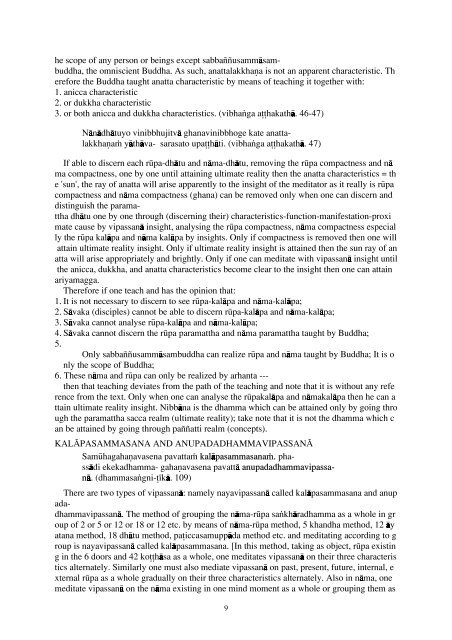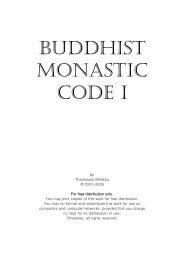Vipassana Kammatthana.pdf
Vipassana Kammatthana.pdf
Vipassana Kammatthana.pdf
Create successful ePaper yourself
Turn your PDF publications into a flip-book with our unique Google optimized e-Paper software.
he scope of any person or beings except sabbaññusammåsambuddha,<br />
the omniscient Buddha. As such, anattalakkhaˆa is not an apparent characteristic. Th<br />
erefore the Buddha taught anatta characteristic by means of teaching it together with:<br />
1. anicca characteristic<br />
2. or dukkha characteristic<br />
3. or both anicca and dukkha characteristics. (vibha∫ga a hakathå. 46-47)<br />
Nånådhåtuyo vinibbhujitvå ghanavinibbhoge kate anattalakkhaˆa◊<br />
yåthåva- sarasato upa håti. (vibha∫ga a hakathå. 47)<br />
If able to discern each rËpa-dhåtu and nåma-dhåtu, removing the rËpa compactness and nå<br />
ma compactness, one by one until attaining ultimate reality then the anatta characteristics = th<br />
e 'sun', the ray of anatta will arise apparently to the insight of the meditator as it really is rËpa<br />
compactness and nåma compactness (ghana) can be removed only when one can discern and<br />
distinguish the paramattha<br />
dhåtu one by one through (discerning their) characteristics-function-manifestation-proxi<br />
mate cause by vipassanå insight, analysing the rËpa compactness, nåma compactness especial<br />
ly the rËpa kalåpa and nåma kalåpa by insights. Only if compactness is removed then one will<br />
attain ultimate reality insight. Only if ultimate reality insight is attained then the sun ray of an<br />
atta will arise appropriately and brightly. Only if one can meditate with vipassanå insight until<br />
the anicca, dukkha, and anatta characteristics become clear to the insight then one can attain<br />
ariyamagga.<br />
Therefore if one teach and has the opinion that:<br />
1. It is not necessary to discern to see rËpa-kalåpa and nåma-kalåpa;<br />
2. Såvaka (disciples) cannot be able to discern rËpa-kalåpa and nåma-kalåpa;<br />
3. Såvaka cannot analyse rËpa-kalåpa and nåma-kalåpa;<br />
4. Såvaka cannot discern the rËpa paramattha and nåma paramattha taught by Buddha;<br />
5.<br />
Only sabbaññusammåsambuddha can realize rËpa and nåma taught by Buddha; It is o<br />
nly the scope of Buddha;<br />
6. These nåma and rËpa can only be realized by arhanta --then<br />
that teaching deviates from the path of the teaching and note that it is without any refe<br />
rence from the text. Only when one can analyse the rËpakalåpa and nåmakalåpa then he can a<br />
ttain ultimate reality insight. Nibbåna is the dhamma which can be attained only by going thro<br />
ugh the paramattha sacca realm (ultimate reality); take note that it is not the dhamma which c<br />
an be attained by going through paññatti realm (concepts).<br />
KALÓPASAMMASANA AND ANUPADADHAMMAVIPASSANÓ<br />
SamËhagahaˆavasena pavatta◊ kalåpasammasana◊. phassådi<br />
ekekadhamma- gahaˆavasena pavattå anupadadhammavipassanå.<br />
(dhammasa∫gni- ¥kå. 109)<br />
There are two types of vipassanå: namely nayavipassanå called kalåpasammasana and anup<br />
adadhammavipassanå.<br />
The method of grouping the nåma-rËpa sa∫khåradhamma as a whole in gr<br />
oup of 2 or 5 or 12 or 18 or 12 etc. by means of nåma-rËpa method, 5 khandha method, 12 åy<br />
atana method, 18 dhåtu method, pa iccasamuppåda method etc. and meditating according to g<br />
roup is nayavipassanå called kalåpasammasana. [In this method, taking as object, rËpa existin<br />
g in the 6 doors and 42 ko håsa as a whole, one meditates vipassanå on their three characteris<br />
tics alternately. Similarly one must also mediate vipassanå on past, present, future, internal, e<br />
xternal rËpa as a whole gradually on their three characteristics alternately. Also in nåma, one<br />
meditate vipassanå on the nåma existing in one mind moment as a whole or grouping them as<br />
9






